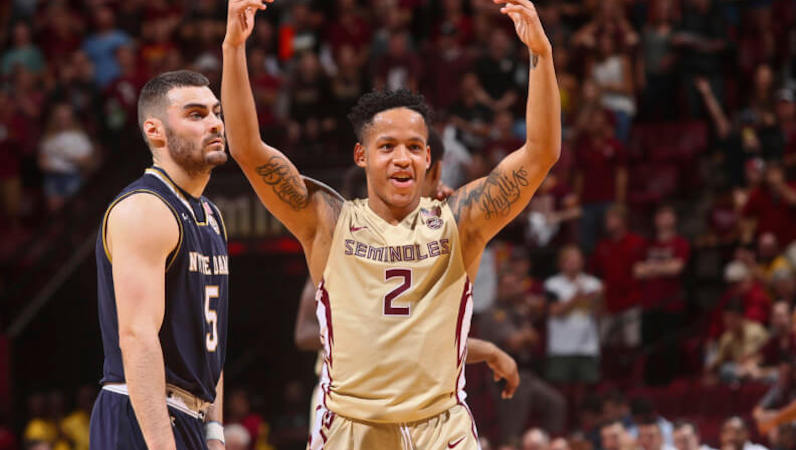The 2016-17 Florida State Seminoles found success blending efficiency with volume when it came to transition offense.
According to Synergy Sports, Florida State basketball scored 1.15 points per possession in transition this season; that ranks second in the ACC (No. 26 in Division I) in terms of efficiency. The Seminoles shot 59 percent on transition field goals — good for third in the league.
Those are remarkable statistics; what’s more jarring, though, is the team’s relentless desire to get out and fun. FSU spent 20.6 percent of its possessions in transition, per Synergy. That’s the highest number in the ACC. In total, Florida State scored 693 points in transition, which is also tops in the league.
Florida State, running the break
Weirdly enough, the term fast break and Florida State are probably most synonymous on the football pitch. You can thank Charlie Ward and FSU’s uptempo offense of the early 1990s for that notion. However, in recent years, Florida State basketball has strongly emphasized the runout.
| Season | Points per possession | Total points | Percent of possessions |
|---|---|---|---|
| 2011-12 | 1.07 | 443 | 15.2% |
| 2012-13 | 0.96 | 329 | 13.4% |
| 2013-14 | 1.16 | 567 | 17.7% |
| 2014-15 | 0.95 | 407 | 17.6% |
| 2015-16 | 1.12 | 679 | 21.6% |
| 2016-17 | 1.15 | 693 | 20.6% |
Over the last two seasons, Florida State and North Carolina are the only two ACC programs to score 600-plus transition points in both seasons (2015-17).
Prior to the 2016-17 campaign, Leonard Hamilton was vocal that the team would push the pace more. This is what you do when your three best players are perimeter-oriented: Jonathan Isaac, Dwayne Bacon and Xavier Rathan-Mayes.
The Seminoles scored more overall points in transition this season, but per Synergy, a higher percentage of the team’s possessions came in the half-court, albeit a small amount.
According to KenPom, FSU basketball ranked No. 16 nationally in average possession length (15.3 seconds), which supports this narrative.
Key components
A primary principle of Florida State’s fast break is the presence at least one fleet-footed big man. Obviously, when we think about running and gunning on the court, naturally we envision guards sprinting up and down. However, a rim-running post player can be an absolute force.
In the NBA, Cody Zeller does this with the Charlotte Hornets; Blake Griffin did the same with the Los Angeles Clippers. The post player sprints the floor, and tries to get ahead of the defense; if he’s successful, great, it’s likely a slam dunk. If not, though, that player at least draws attention.
The rim sprint makes a defense that’s in Retreat Mode focus its attention at the rim, which can open up the wings for catch-and-shoot three-pointers. Transition is, of course, the best time to shoot a three-pointer.
It’s good for FSU, too, that this team featured two big guys that had success in transition: Michael Ojo and Christ Koumadje. Those two players — on a small sample — shot a combined 70 percent in transition.
Reasons to stay optimistic
The departures of XRM, Bacon and especially Isaac will be felt in Tallahassee. Isaac was a rare talent. Without those half-court cogs, though, it may not be a bad idea for Florida State to run a little more this season. The Seminoles — at least on paper — don’t have the one-on-one scorers of years past.
FSU does, however, return several perimeter players that have some transition equity. Terance Mann, Trent Forrest and C.J. Walker all shot above 54 percent in transition this season.
The Seminoles will also add 4-star shooting guard M.J. Walker — a top-30 recruit — to the rotation as well.
We have to mention PJ Savoy here, too. Savovy — a favorite of ours at the ACC Analytics page — is an explosive shooter. The 6-foot-4 guard scored 43 points on 28 transition shooting possession. It should be noted that almost 88 percent of Savoy’s attempts from the floor are three-pointers; transition basketball is the best time to let it fly from deep.
Inside the Playbook series
Kyle Guy and the pindown screen
Joel Berry, Luke Maye and pick-and-pop madness
Georgia Tech basketball’s back cut mastery
Duke basketball and the increasingly popular DHO
Wake Forest fights ice with fire on its side PNRs
Syracuse basketball and its game of zones
UNC basketball and its vaunted secondary break
Miami basketball and the offense of a thousand screens
Louisville basketball, Quentin Snider and the high ball screen
Luke Kennard and Duke’s naturally curly offense
Kenny William, Cam Johnson could create headaches for ACC foes

















